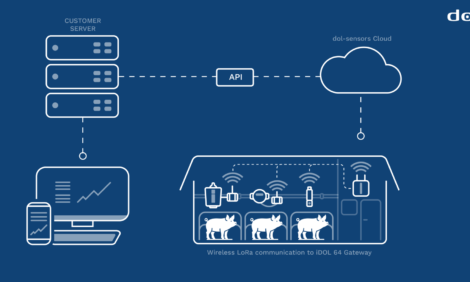



EU-27 Livestock and Products Annual 2007
By USDA, Foreign Agricultural Service - This article provides the pork industry data from the USDA FAS Livestock and Products Annual 2007 report for the EU-27. A link to the full report is also provided. The full report includes all the tabular data which we have omitted from this article.Report Highlights:
Bulgaria and Romania joined the EU to form the EU-27 at the beginning of the year. This should only have minor impacts on EU meat markets, although meat imports will drastically decrease as a result of EU legislation.
The EU pig and pork market is peaking in 2007, after a profitable 2006. However, oversupplies and increased feed costs are eating into this profitability and pork production is forecast to slightly decrease in 2008. EU pork exports are forecast to loose market share in 2008, while the increase in domestic pork consumption is forecast to level off.
Executive Summary
The beginning of 2007 brought another expansion of the European Union, with two additional member states (MS): Bulgaria and Romania. While this enlargement is much smaller than the 2004 accession of ten New Member States (NMS-10), it again integrates two poorer countries, adding 29 million inhabitants, in which agriculture is an important economic sector and employer. However, both countries are net meat importers and will therefore have a minor impact on EU meat markets. Bulgaria and Romania combined add four percent to the EU cattle herd size and slightly less to the EU pig population, with Romania providing 90 percent of the pigs. One of the main impacts of this enlargement on the EU market was the threat from Russia to close its border for all EU animal products, for fear for the animal health situation in Bulgaria and Romania, especially for Classical Swine Fever (CSF) and Avian Influenza (AI).Pig and pork production are expected to further increase by 1.6 percent in 2007, as they were stimulated by profitable market conditions in 2006. However, an oversupply situation, especially in Poland, has pushed pig prices down at the beginning of 2007 and increasing feed costs are eating into profitability. As a result, EU pig production is forecast to slow down at the end of 2007 and in 2008. Former imports of U.S. and Canadian pork to the two new MS, mainly Romania, strongly decrease in 2007 as a result of higher EU import tariffs. EU pork exports are struggling to keep up in 2007. Decreasing Danish pork exports to Japan, as a result of the return of U.S. beef and increased competition from Canada, are being redirected to Russia and South Korea. EU domestic pork consumption is further increasing in 2007, but this increase is forecast to level off in 2008.
Swine
2006
The accession of Bulgaria and Romania to the European Union (EU) on January 1, 2007 added some 5.9 million head to the EU swine herd, taking the total to almost 160 million pigs. Romania accounts for more than 80 percent of the increase. Swine numbers in the EU-25 also increased by 0.2 percent compared to 2005, mainly as a result of expanding pig herds in Poland and Germany.
Pig production in 2006 increased by 0.5 percent, with increases recorded, beside Poland and Germany, in Spain, Denmark and The Netherlands. Increased pig production in the latter two countries was mainly for export of piglets to the NMS, including to Bulgaria and Romania, but also for exports outside the EU, mainly Croatia, Serbia, and Russia. The Benelux exported 6 million pigs and piglets, almost 0.5 million outside the EU. Meanwhile Denmark also exported 4.4 million pigs and piglets, some 45,000 outside the EU. Swedish farmers are optimistic about pig breeding in Sweden as investments in new stables quadrupled in 2006 compared to 2004. Important numbers of slaughter pigs are traded intra-EU to Germany, Italy, Hungary, and to a lesser extent Spain. A minor outbreak of Classical Swine Fever (CSF) close to the western border of Germany led to the destruction of 92,000 pigs, but did not disrupt markets. Pig slaughter in the EU-25 increased by more than 1 percent, with increases in Germany (+4%), Italy (+3%), Spain (+4%) and Poland (+6%), partly offset by decreases in The Benelux, Denmark, France and Hungary.
2007
Profitable pig market conditions throughout 2006 are stimulating further pig production increases in 2007. The 2006 December census showed an increase in EU-27 pig numbers of 1.6 percent, while sow numbers increased by 0.7 percent. This is expected to lead to a further increase in pig production of 0.7 percent. Further production increases are expected in Austria, Denmark, the Benelux, Italy and Romania; with renewed growth in the United Kingdom and Hungary. However, production is slowing in Germany, the Czech Republic, and Poland, which suffers from overproduction as attempts to overcome the Russian ban on imports from Poland have failed so far. This has depressed pig prices in the EU to below the 5-year average price in the first quarter of 2007, after which pig prices have started to increase seasonally again. This has hurt profitability significantly, especially in Poland, because feed cost also increased compared to 2006. Increasing exports of mainly piglets are expected to Russia and Croatia. However, problems with animal welfare for pigs in transportation could hamper Danish exports of pigs for slaughter to more distant destinations. EU expert committee slaughter previsions expect an increase in 2007 pig slaughter of 1.6 percent for the EU-25, with the largest increases expected in Germany, Italy and the United Kingdom, while slaughter in Poland should decrease again.
Slaughter in Romania is expected to further increase too, as more slaughter capacity that meets EU hygiene requirements comes online. It can also be expected that on farm slaughter, which is almost half of the total slaughter in Romania, will gradually decrease in the coming years. A similar development is expected in Bulgaria.
2008
EU-27 pig numbers are forecast to stabilize and marginally fall during 2008, with sow numbers and hence pig production slightly decreasing to the 2006 level again. While further production increases are forecast in Denmark, Germany, Italy, and Romania, decreases are forecast in the Benelux, the Czech and Slovak Republics, Hungary, and Poland. Polish pig farmers fear further profitability losses in 2008, as the implementation of the Polish ban on GMO’s in feed, which is foreseen for August of 2008, is expected to further increase feed costs. Pig exports are forecast continue at the same level. As a result, EU-27 slaughter in 2008 is forecast to decrease by 0.5 million head or 0.2 percent.
Pork
2006
A 1.5 percent increase in EU pork production in 2006, compared to 2005, did not lead to a decrease in pork prices. On the contrary, pork consumption in the beginning of 2006 also benefited from the AI related decrease in poultry consumption. This was also the case in Romania, less so in Bulgaria, where pork consumption per capita is much lower. In the second half of 2006 some commercial stock building from extra-EU imports into Romania, especially from Canada, seem to have occurred. As a result, consumption numbers for 2006 are overstated, while consumption numbers for 2007 may be underestimated. EU exports of pork accelerated in the last quarter of 2006, mainly to Russia and South Korea. This resulted from the fact that Danish pork exporters refocused exports away from Japan, where pork consumption was stagnating as U.S. beef re-entered the market and competition from Canadian and U.S. pork was increasing. Increased pork demands from Russia turned out more profitable for Danish exporters.
In December 2006, Romania adopted a new vaccination plan against CSF. Romania’s CSF problem had already triggered an EU ban on all Romanian pig and pork exports in 2003. The plan includes vaccination with “live” vaccine of all backyard pigs and wild boar using baits, while commercial pig herds are vaccinated with “marker” vaccines. This vaccination was necessary after Romania registered 780 outbreaks of CSF in 2006. Bulgaria also stopped classical vaccination both at commercial and backyard farms against CSF in 2006. Despite these efforts, slow and inefficient implementation of the eradication program and CSF outbreaks in 06/07 resulted in an EU ban until September 2007. The most recent EU inspection on implementation of the CSF eradication program was reportedly negative and a continuation of the export ban is likely for another 6 months or more.
2007
EU pork production in 2007 is expected to increase another 1.6 percent in line with increased slaughter. This increase in production is mostly expected in the EU-15 and the two new MS, where it will mainly offset decreased imports from non-EU countries. Due to the adoption of EU import tariffs and regulations, Bulgaria and Romania are expected to import about 100,000 MT less pork in total, mainly from Canada and the United States. EU pork exports are expected to stabilize in 2007 as competition from Brazil in Russia and from Canada and the United States in Asia are increasing. The continued ban from Russia on Polish meat and the ban from Japan on Hungarian pork further hamper EU pork exports. Exports to Russia decreased more than half in the first months of 2007, despite the agreement that the EU had with Russia on increased safety guarantees upon the accession of Bulgaria and Romania. While Danish pork exports to Japan further decrease, Danish pork is also facing stiffer competition in the Russian market, mainly from pork from Brazil. Domestic consumption is expected to further increase, mainly in the EU-15. However, the low pork prices compared to broiler prices are not expected to lead to any significant substitution because consumer prices do not follow producer prices. EU consumption is also somewhat overstated as it includes some 26,000 MT of stocks that the Polish government has built for its strategic reserve.
2008
EU pork production is forecast to decrease 0.5 percent again in 2008, in line with decreasing slaughter. It is expected that high EU pork prices will further erode EU exports, especially if Brazil improves its FMD status. EU dome stic consumption of pork is forecast to increase slightly.
To view the full report, please click here






